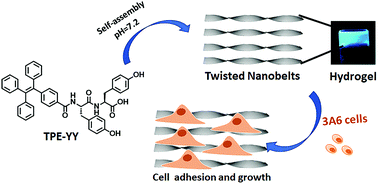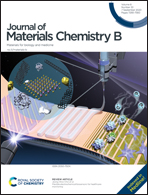Construction of self-assembled nanostructure-based tetraphenylethylene dipeptides: supramolecular nanobelts as biomimetic hydrogels for cell adhesion and proliferation†
Abstract
Supramolecular fluorescent materials with aggregation-induced emission (AIE) characteristics have promising applications as fluorescent probes for bio and chemosensors. In this study, a versatile low molecular weight tetraphenylethylene dipeptide hydrogelator (TPE-YY) with efficient AIE characteristics was developed, which was able to form hydrogels in a broad pH range from 3.7 to 10.2. The self-assembly of this hydrogel is completely pH-dependent, with significant structural transitions from high to low pH. At a relatively high pH value (10.2), a weak transparent hydrogel with an entangled network of nanofibers was obtained, while upon neutralization (pH 7.2) with dilute HCl, a stable semi-transparent gel with twisted nanobelts was formed. When the pH of the hydrogel was reduced to below 5.7, a turbid viscous gel and precipitation appeared with the thickening of the nanobelts. Surprisingly, the hydrogel resulting from the glucono-δ-lactone triggered gel showed only nanofibers independent of pH. The nature of the hydrogels and the nanostructures at different pH values were thoroughly examined and discussed via oscillatory rheology, electron microscopy and various spectroscopic techniques {1HNMR, 2D-NMR, Fourier transform infrared (FTIR) and Circular dichroism (CD)}. Interestingly, the self-assembled hydrogel exhibited excellent biocompatibility over 95% using hydrogel leachables on two different cell lines, 3A6 (human MSCs) and L929 (mouse fibroblast cells). Moreover, the self-assembled nanobelts formed at neutral pH showed excellent cell adhesion and proliferation of 3A6 cells, whereas the nanofibers showed poor cell adhesion and proliferation. Overall, we demonstrate the importance of chemical design for the formation of self-assembled nanobelts and supramolecular hydrogels at physiological pH with selective cell adhesion and proliferation, presenting a promising applications in tissue engineering and regenerative medicine.

- This article is part of the themed collection: Editor’s Choice: Tissue Engineering


 Please wait while we load your content...
Please wait while we load your content...